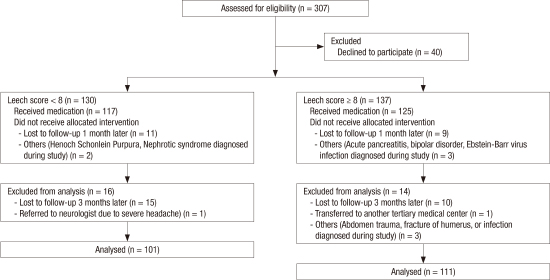1. Hoekman DR, Rutten JM, Vlieger AM, Benninga MA, Dijkgraaf MG. Annual costs of care for pediatric irritable bowel syndrome, functional abdominal pain, and functional abdominal pain syndrome. J Pediatr. 2015; 167:1103–1108.e2.
2. Bufler P, Gross M, Uhlig HH. Recurrent abdominal pain in childhood. Dtsch Arztebl Int. 2011; 108:295–304.
3. Chiou FK, How CH, Ong C. Recurrent abdominal pain in childhood. Singapore Med J. 2013; 54:195–199.
4. Chitkara DK, Rawat DJ, Talley NJ. The epidemiology of childhood recurrent abdominal pain in Western countries: a systematic review. Am J Gastroenterol. 2005; 100:1868–1875.
5. Eidlitz-Markus T, Mimouni M, Zeharia A, Nussinovitch M, Amir J. Occult constipation: a common cause of recurrent abdominal pain in childhood. Isr Med Assoc J. 2004; 6:677–680.
6. Freedman SB, Thull-Freedman J, Manson D, Rowe MF, Rumantir M, Eltorki M, Schuh S. Pediatric abdominal radiograph use, constipation, and significant misdiagnoses. J Pediatr. 2014; 164:83–88.e2.
7. Gijsbers CF, Kneepkens CM, Schweizer JJ, Benninga MA, Büller HA. Recurrent abdominal pain in 200 children: somatic causes and diagnostic criteria. Acta Paediatr. 2011; 100:e208–14.
8. Drossman DA. The functional gastrointestinal disorders and the Rome III process. Gastroenterology. 2006; 130:1377–1390.
9. Jones MP, Dilley JB, Drossman D, Crowell MD. Brain-gut connections in functional GI disorders: anatomic and physiologic relationships. Neurogastroenterol Motil. 2006; 18:91–103.
10. Levy RL, Olden KW, Naliboff BD, Bradley LA, Francisconi C, Drossman DA, Creed F. Psychosocial aspects of the functional gastrointestinal disorders. Gastroenterology. 2006; 130:1447–1458.
11. Le Pluart D, Sabaté JM, Bouchoucha M, Hercberg S, Benamouzig R, Julia C. Functional gastrointestinal disorders in 35,447 adults and their association with body mass index. Aliment Pharmacol Ther. 2015; 41:758–767.
12. Chang SH, Park KY, Kang SK, Kang KS, Na SY, Yang HR, Uhm JH, Ryoo E. Prevalence, clinical characteristics, and management of functional constipation at pediatric gastroenterology clinics. J Korean Med Sci. 2013; 28:1356–1361.
13. Korterink JJ, Rutten JM, Venmans L, Benninga MA, Tabbers MM. Pharmacologic treatment in pediatric functional abdominal pain disorders: a systematic review. J Pediatr. 2015; 166:424–431.e6.
14. Levy RL, van Tilburg MA. Functional abdominal pain in childhood: background studies and recent research trends. Pain Res Manag. 2012; 17:413–417.
15. Gijsbers CF, Kneepkens CM, Vergouwe Y, Büller HA. Occult constipation: faecal retention as a cause of recurrent abdominal pain in children. Eur J Pediatr. 2014; 173:781–785.
16. Treepongkaruna S, Simakachorn N, Pienvichit P, Varavithya W, Tongpenyai Y, Garnier P, Mathiex-Fortunet H. A randomised, double-blind study of polyethylene glycol 4000 and lactulose in the treatment of constipation in children. BMC Pediatr. 2014; 14:153.
17. Leech SC, McHugh K, Sullivan PB. Evaluation of a method of assessing faecal loading on plain abdominal radiographs in children. Pediatr Radiol. 1999; 29:255–258.
18. Tomlinson D, von Baeyer CL, Stinson JN, Sung L. A systematic review of faces scales for the self-report of pain intensity in children. Pediatrics. 2010; 126:e1168–98.
19. Loening-Baucke V, Swidsinski A. Constipation as cause of acute abdominal pain in children. J Pediatr. 2007; 151:666–669.
20. Koh H, Lee MJ, Kim MJ, Shin JI, Chung KS. Simple diagnostic approach to childhood fecal retention using the Leech score and Bristol stool form scale in medical practice. J Gastroenterol Hepatol. 2010; 25:334–338.
21. van den Bosch M, Graafmans D, Nievelstein R, Beek E. Systematic assessment of constipation on plain abdominal radiographs in children. Pediatr Radiol. 2006; 36:224–226.
22. Thompson WG, Longstreth GF, Drossman DA, Heaton KW, Irvine EJ, Müller-Lissner SA. Functional bowel disorders and functional abdominal pain. Gut. 1999; 45:Suppl 2. II43–7.
23. Gieteling MJ, Bierma-Zeinstra SM, Passchier J, Berger MY. Prognosis of chronic or recurrent abdominal pain in children. J Pediatr Gastroenterol Nutr. 2008; 47:316–326.
24. Burgers RE, Mugie SM, Chase J, Cooper CS, von Gontard A, Rittig CS, Homsy Y, Bauer SB, Benninga MA. Management of functional constipation in children with lower urinary tract symptoms: report from the Standardization Committee of the International Children’s Continence Society. J Urol. 2013; 190:29–36.
25. Longo WE, Vernava AM 3rd. Prokinetic agents for lower gastrointestinal motility disorders. Dis Colon Rectum. 1993; 36:696–708.
26. Raahave D. Faecal retention: a common cause in functional bowel disorders, appendicitis and haemorrhoids--with medical and surgical therapy. Dan Med J. 2015; 62:1–42.
27. Mt-Isa S, Tomlin S, Sutcliffe A, Underwood M, Williamson P, Croft NM, Ashby D. Prokinetics prescribing in paediatrics: evidence on cisapride, domperidone, and metoclopramide. J Pediatr Gastroenterol Nutr. 2015; 60:508–514.
28. Jeong SJ. Fecal retention in overactive bladder (OAB) in children: perspective of a pediatric gastroenterologist. Child Kidney Dis. 2015; 19:1–7.
29. Burgers R, Liem O, Canon S, Mousa H, Benninga MA, Di Lorenzo C, Koff SA. Effect of rectal distention on lower urinary tract function in children. J Urol. 2010; 184:1680–1685.







 PDF
PDF ePub
ePub Citation
Citation Print
Print






 XML Download
XML Download